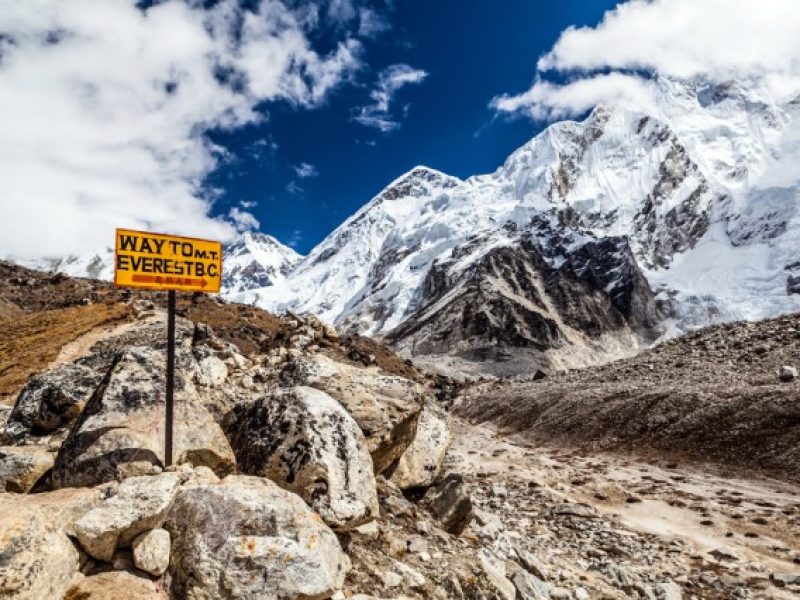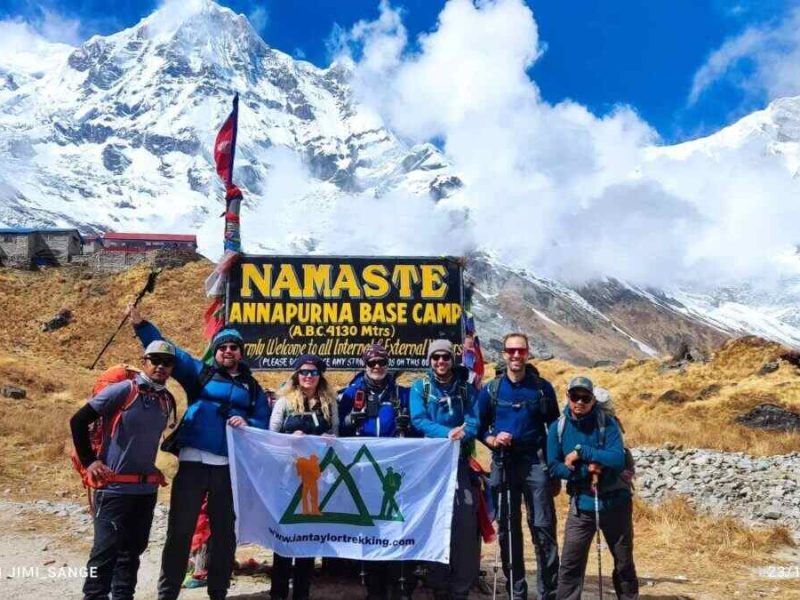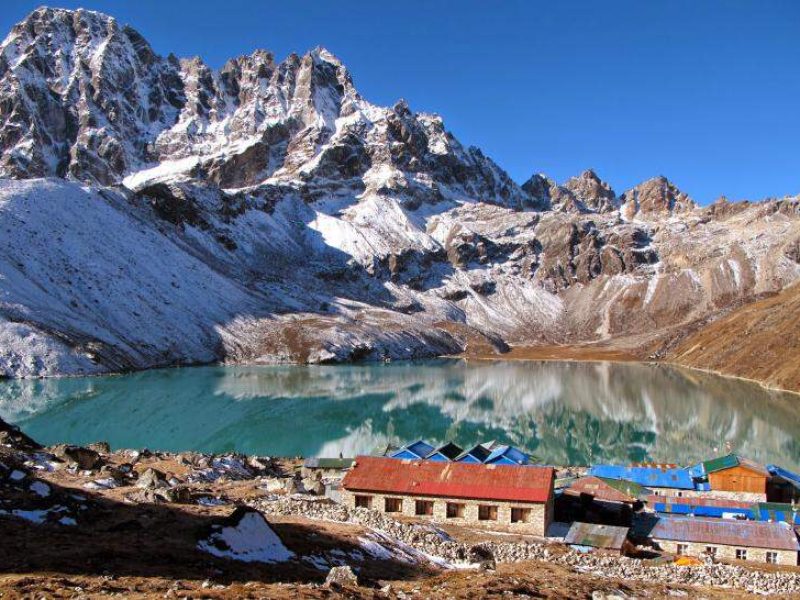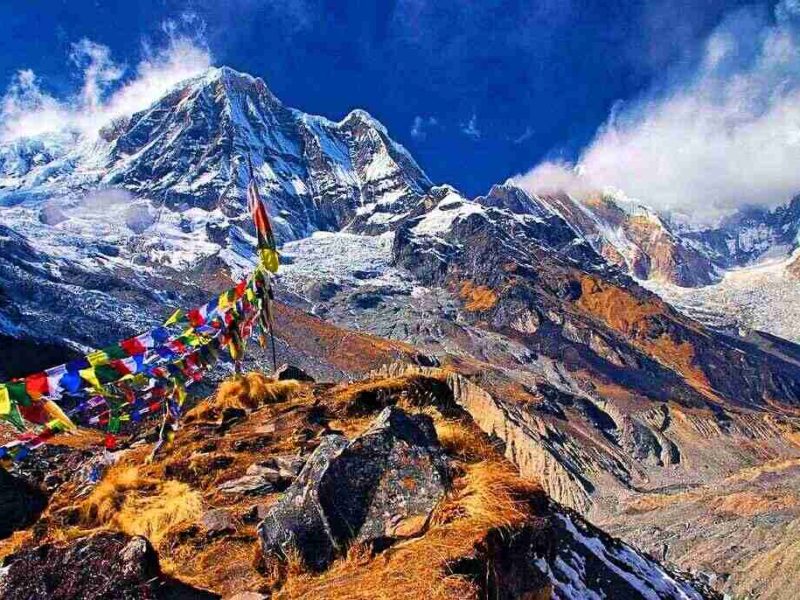Explore the base camp treks of a lifetime. Discover breathtaking views, cultural immersion and essential tips for an unforgettable journey. Everest Base Camp (EBC) and Annapurna Base Camp (ABC) are popular destinations for mountaineers and trekkers seeking adventure in the Himalayas. Both treks present unique challenges and rewards, attracting adventurers worldwide.
The Annapurna Base Camp trek(ABC) is situated at 4,130 meters. It offers a serene setting surrounded by towering peaks and charming villages. It takes hikers through lush forests, terraced fields and traditional villages. Experience nature at its most awe-inspiring and create lasting memories.
Everest Base Camp (EBC) is located at 5,364 meters which serves as the starting point for expeditions to Mount Everest. It offers a unique experience with a community of tents and temporary structures.
Both camps provide unforgettable experiences offering the thrill of summiting Everest or excitement of trekking to Annapurna’s base. Both camps offer unforgettable Himalayan experiences.
Trek Durations And Challenges Of Everest & Annapurna Base Camp
The Everest Base Camp and Annapurna Base Camp treks have varying durations depending on factors like the chosen route, fitness levels, acclimatization needs and weather conditions. The Everest Base Camp trek takes 12-16 days covering 130 kilometers and averaging 8-10 days. The Annapurna Base Camp trek is shorter, covering 7-12 days and covering 65 kilometers.
Both treks involve moderate to difficult hiking with daily durations averaging 5-7 hours. Both treks are challenging and rewarding but require preparedness for variable weather and altitude challenges.
Starting Points For The Trek To Everest & Annapurna Base Camp
The trek to Everest Base Camp begins in Lukla, a town known for its stunning views of the Himalayas. The trail follows a well-established trail through Sherpa villages, dense forests and rugged mountain terrain.
The journey takes 8 to 10 days, with trekkers spending nights at tea houses or lodges. The journey offers stunning views of snow-capped peaks like Everest, Lhotse, Nuptse and Ama Dablam. The final destination is Everest Base Camp offering panoramic views of the Khumbu Icefall and surrounding Himalayan giants.
The Annapurna Base Camp trek in Nepal begins from Nayapul or Pokhara, both popular tourist destinations. Trekkers can start from Nayapul or Pokhara with Nayapul being the primary starting point.
The trail follows charming villages, terraced farmlands and lush forests offering opportunities to immerse in local culture. The trek takes 7 to 12 days depending on the itinerary and pace.
Trekkers spend nights at tea houses or lodges enjoying the stunning mountain scenery. The journey ends at Annapurna Base Camp offering close-up views of towering peaks and a sense of accomplishment.
Highlights Of Everest Base Camp (EBC)

The Everest Base Camp (EBC) trek is a popular and iconic trekking destination in the world offering stunning mountain views, Sherpa culture and hospitality. The trek passes through traditional Sherpa villages where visitors can explore ancient monasteries and mani stones.
Namche Bazaar, a busy Sherpa town serves as a commercial hub offering visitors a chance to adjust to the altitude. Tengboche Monastery, a monastery that offers visitors a chance to witness Buddhist rituals and mountain panoramas.
The ultimate highlight is reaching Everest Base Camp at an altitude of 5,364 meters, where trekkers can celebrate their achievement. A side trip to Kala Patthar provides panoramic views of Everest, Lhotse and surrounding peaks.
Highlights Of Annapurna Base Camp (ABC)
The Annapurna Base Camp (ABC) trek offers a unique experience as it showcases the natural beauty and cultural richness of the Annapurna region. The trek passes through the Annapurna Massif, passing through charming villages and rhododendron forests where trekkers can involve themselves in local culture and traditions.

The region is home to different types of flora and fauna including rare species like the snow leopard and Himalayan thar. After a challenging day of trekking, trekkers can relax in the natural hot springs near Jhinu Danda.
The ultimate highlight is reaching Annapurna Base Camp, situated at an altitude of approximately 4,130 meters, where they can admire the Annapurna sanctuary, a glimpse of glacial valleys and soaring cliffs.
Essentials Gear And Preparation For Unforgettable Base Camp Treks
Everest Base Camp (EBC)
Trekking to Everest Base Camp (EBC) requires careful preparation and the right gear. Essential gear includes moisture-wicking base layers, insulation layers, waterproof outer shells, trekking pants and shorts, thermal underwear, warm hats and gloves, strong hiking boots and thick socks.
A backpack with adjustable straps and padded hip belt is essential as is a daypack for water, snacks and camera. Sleeping gear includes a sleeping bag and pad, sunglasses, headlamp, trekking poles, insulated water bottles, sunscreen, lip balm and a first aid kit.
Personal items include a valid passport, trekking permits, and TIMS card. Personal items include cash, toiletries, and physical fitness. Preparation includes regular cardiovascular exercise, altitude acclimatization, training hikes and weather research.
By preparing adequately and packing the right gear, you can start on the Everest Base Camp trek with confidence ensuring a memorable and rewarding experience amidst the breathtaking Himalayan landscapes.
Annapurna Base Camp (ABC)
Trekking to Annapurna Base Camp (ABC) requires the right gear and preparation. Essential clothing includes moisture-wicking base layers, insulation layers, waterproof and windproof jackets, trekking pants, warm hats, sun hats, sturdy hiking boots and comfortable socks.
A lightweight backpack with a rain cover and sleeping gear is also essential. Trekking equipment includes trekking poles, headlamps, water bottles, sunscreen, hygiene items and medications. Navigation and communication tools include maps, GPS devices and portable chargers.
Permits and documentation are required, including the Annapurna Conservation Area Permit (ACAP) and the Trekkers’ Information Management System Card (TIMS). Physical fitness and acclimatization are essential for the journey. Hiring a local guide and porter can enhance safety and provide cultural insights.
By preparing with the right gear, clothing and essential items, and ensuring physical fitness and acclimatization, trekkers can embark on a successful and rewarding journey to Annapurna Base Camp.
Physical Preparation For Himalayan Trekking Adventures
- Trekking to Everest Base Camp (EBC) and Annapurna Base Camp (ABC) demands high fitness levels and endurance.
- Walk for 5 to 7 hours daily over varied terrain during the trek.
- Regular aerobic exercise is essential for health at high altitudes.
- Strong muscles are needed for climbing steep trails and carrying a backpack.
- Maintain core stability for balance and stability during the trek.
- Stretch regularly to improve flexibility and prevent injuries.
- Acclimatize to higher altitudes to understand and cope with altitude effects.
- Stay hydrated and maintain proper nutrition for energy during the trek.
- Start training months before the trek including hiking with a loaded backpack.
- Seek advice from healthcare professionals or fitness trainers before the trek and gradually increase training intensity.
Trekking Path From Easy To Adventurous Routes
Trekking to Everest Base Camp (EBC) offers various routes with varying difficulty levels and durations. The classic route starts from Lukla and involves gradual ascents and descents through Sherpa villages. The final stretch involves crossing the Khumbu Glacier and the Khumbu Icefall.
The Jiri to EBC route follows the original route taken by Sir Edmund Hillary and Tenzing Norgay Sherpa during the first successful Everest expedition in 1953. The Gokyo Lakes and Everest Base Camp Trek combines the trek to EBC with a visit to the Gokyo Lakes in the Gokyo Valley.

The Everest Three Passes Trek is the most challenging and adventurous option, crossing three high mountain passes. Each route offers unique challenges and rewards requiring proper preparation, acclimatization and a sense of adventure for a successful trek.
Trekking to Annapurna Base Camp (ABC) offers various routes with varying difficulty levels. The classic route starts from Nayapul, accessible by road from Pokhara and passes through remote villages. The route offers panoramic views of the Annapurna and Dhaulagiri mountain ranges and a steep ascent.
The Annapurna Circuit Trek with ABC Extension combines the classic route with an extension to Annapurna Base Camp, offering a comprehensive experience.
The Ghorepani Poon Hill Trek with ABC Extension is a shorter, more accessible option, starting from Nayapul and following the Ghorepani Poon Hill trail. Both routes present unique challenges and highlights, but proper preparation, acclimatization and a sense of adventure are essential for a successful trek.
Accommodation Choices From Teahouses To Homestays In the Himalayas
Trekkers can choose from various accommodation options during their journey to Everest Base Camp and Annapurna Base Camp. Teahouses or lodges are the most popular offering basic guest houses with shared bathrooms and communal dining areas.
Camps provide a more adventurous experience offering stunning views and freedom. Luxury lodges and resorts offer upscale accommodations with amenities like spacious rooms, high-quality linens and gourmet dining.
Homestays with local families offer authentic Nepali hospitality and a unique opportunity to immerse oneself in the local culture. These accommodations cater to a wide range of preferences, budgets and comfort levels ensuring a memorable experience amidst the breathtaking Himalayan landscapes.
Despite the higher cost, these accommodations provide a level of comfort and luxury rarely found in remote mountainous regions.
Safety Guidelines For Trekking To Everest & Annapurna Base Camp
Safety is crucial during treks to Everest Base Camp (EBC) and Annapurna Base Camp (ABC) due to the challenging terrain, high altitudes, and remote locations. To ensure safety, follow these safety measures:

- Acclimatize slowly by gradually ascending to the high altitude and following a well-paced itinerary with rest days. Drink plenty of water to stay hydrated and prevent altitude sickness.
- Recognize symptoms of altitude sickness such as headache, nausea, dizziness, fatigue, and difficulty sleeping. Descend to a lower altitude if symptoms worsen or persist.
- Wear appropriate clothing, including layers, waterproof jackets, sturdy hiking boots, and insulated gloves and hats. Carry essential trekking gear such as a headlamp or flashlight, trekking poles, a first aid kit and a map or GPS device for navigation.
- Monitor weather forecasts and adjust plans accordingly.
- Know altitude limits and prioritize safety over reaching high points. Use a portable altitude sickness monitor to monitor oxygen saturation levels and assess altitude sickness risk.
- Prepare for emergencies by carrying emergency contacts, a first aid kit, and signaling devices for help.
- Purchase travel insurance that covers medical emergencies, evacuation, and trip cancellation or interruption.
By following these safety measures and exercising caution, trekkers can minimize risks and enjoy a safe and memorable trekking experience to Everest Base Camp or Annapurna Base Camp.
Conclusion
In conclusion, trekking to Everest Base Camp (EBC) and Annapurna Base Camp (ABC) offers an unforgettable experience in the Himalayas and Nepalese mountain communities. The EBC trek takes 12-14 days and includes stunning views of Mount Everest, Sherpa villages, and the summit. The ABC trek takes 7-10 days and includes picturesque villages, lush forests, and an amphitheater of peaks.
Trekkers should prioritize acclimatization, pack essential gear, and practice responsible trekking habits for a safe and enjoyable journey. The experience promises to be unforgettable.
Frequently Asked Questions (FAQs)
1. What is the total duration of the trek to Everest Base Camp (EBC) and Annapurna Base Camp (ABC)?
The total duration of the trek to Everest Base Camp typically ranges from 12 to 14 days, while the trek to Annapurna Base Camp usually takes around 7 to 10 days. However, the actual duration may vary depending on factors such as trekking pace, acclimatization, and chosen itinerary.
2. Where are the starting points for the treks to Everest Base Camp and Annapurna Base Camp?
The starting point for the Everest Base Camp trek is usually Lukla, a town in the Khumbu region of Nepal. Alternatively, trekkers can opt for the longer Jiri route, which starts from the town of Jiri, approximately 187 kilometers from Kathmandu. For Annapurna Base Camp, the trek typically begins from Nayapul, a town accessible by road from Pokhara, Nepal.
3. What are the highlights of the Everest Base Camp trek?
The highlights of the Everest Base Camp trek include stunning views of the world’s highest peaks, including Mount Everest, Sherpa villages such as Namche Bazaar and Tengboche, and reaching Everest Base Camp itself. Trekkers should not miss the opportunity to visit Kala Patthar for panoramic sunrise views of Everest and the surrounding Himalayan peaks.
4. What are the highlights of the Annapurna Base Camp trek?
The highlights of the Annapurna Base Camp trek include picturesque villages like Ghandruk and Chhomrong, lush forests of rhododendron and bamboo, and the awe-inspiring amphitheater of peaks surrounding Annapurna Base Camp. Trekkers should not miss witnessing the sunrise over the Annapurna massif from Poon Hill and the serene beauty of Machapuchare Base Camp.
5. What are some essential things not to miss out on during the Everest Base Camp trek?
Some essential things not to miss out on during the Everest Base Camp trek include acclimatization, packing essential gear and clothing, and visiting iconic viewpoints such as Kala Patthar for sunrise views of Everest.

Comment (0)